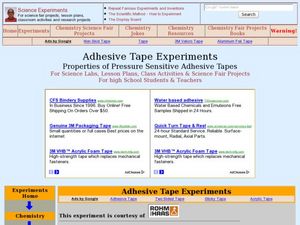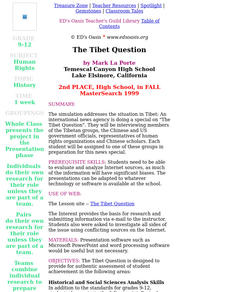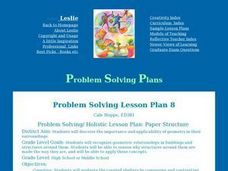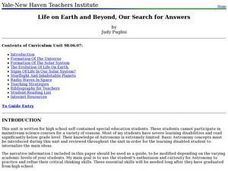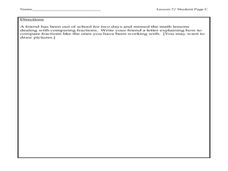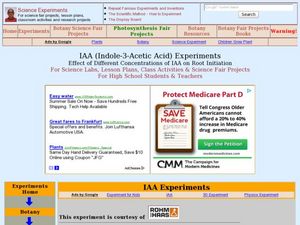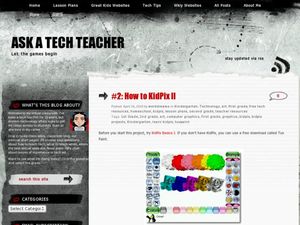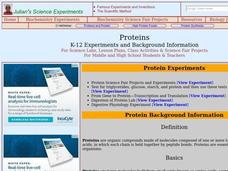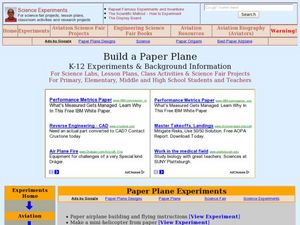Curated OER
Electromagnetic Bomb (E-Bomb)
Students explain how E-bomb works. In this physics lesson, students simulate the effects of e-bombs on electronic targets. They discuss its potential harmful effects when used as a weapon.
Curated OER
Maglev Trains
Students explore how Maglev trains work. In this technology lesson, students discuss the pros and cons of Maglev compared to conventional trains. They build a simple Maglev train model.
Curated OER
"Stick to It!" Properties of Pressure Sensitive Adhesive Tapes
Students investigate the strength of different adhesives. In this physical science lesson, students compare the force needed to peel adhesive tapes from a surface. They analyze collected data and make a generalization.
Curated OER
Chemiluminescence
Students explore chemiluminescence through various experiments. In this chemistry instructional activity, students explain the chemical reaction that drives the process. They give real life applications of chemiluminescence.
Curated OER
Bacteria: Friend or Foe?
Young scholars examine a variety of environmental and industrial roles of bacteria. explore where bacteria can be found and distinguish bacteria from other organisms.
Curated OER
Dealing With Death
Students watch and analyze a video dealing with the topic of death. They answer discussion questions, identify examples of how death is represented in popular media, write a poem, create a memory book, and write a letter to someone who...
Curated OER
Civil Rights Webquest
Students, working individually and in teams, research life in their community during the civil rights era. They take part in a role-playing discussion about civil rights issues based on their research, and create individual and group...
Curated OER
Bringing Justice Home ~First Steps toward Community Action
Students explore activities that might some day bring "justice for all" to their communities. They assess how justice is a day-to-day, life or death matter that faces their communities. Interviews are conducted to explain how justice is...
Curated OER
The Tibet Question
Students participate in a simulation, where they interview members of the Tibetan groups, the Chinese and US government officials, representatives of human rights organizations and Chinese scholars. Each student will be assigned to one...
Curated OER
Problem Solving/ Holistic Lesson Plan: Paper Structure
Students observe geometric relationships in buildings and structures. They reason why structures are constructed in a specific way by applying geometric concepts. They construct a shelter using their geometric knowledge.
Curated OER
Time Travel to the Edge of the Universe and Back!
Students analyze the size of the universe and calculate the time to travel to near and distant destinations.
Curated OER
Energy Alternatives
Students brainstorm a list of all of the ways they use energy in a day. In groups, they research the energy situation today and discuss what is being done to solve the problem. They also examine the issues related to this in politics...
Curated OER
Life on Earth and Beyond, Our Search for Answers
Students in a special education classroom are introduced to how the universe and solar system was formed. Using the internet, they research the characteristics of Earth that support human life. In groups, they compare and contrast...
Curated OER
Virtual Geologic Field Trip to Griffith Park
Students explore the geological processes and research methodology involved in the evolution and development of Griffith Park. They justify the selection of a geologic hypothesis based on observations.
Curated OER
Formulate an Inquiry
Young scholars define questions and issues to be investigated through the photo essay. They practice interviewing skills and write questions defining the topics they want to investigate in their photo essays.
Curated OER
Initial Fraction Ideas Lesson 7: Overview
Third graders recognize that the larger the denominator of a fraction, the smaller the piece you have. In this fraction instructional activity, 3rd graders compare fractions and order them from largest to smallest. Students complete an...
Curated OER
First Things First: Using the Newspaper to Teach the Freedoms of the First Amendment
Students use the newspaper as a tool to make connections about what the five freedoms guarantee in the First Amendment. For this first amendment lesson plan, students analyze events in the newspaper to form conclusions about the freedoms...
Curated OER
Auxin: Indole-3-Acetic Acid (AAA), A Hormone with Diverse Effects: Synthesis and Applications
Learners synthesize Indole-3-Acetic acid from 3-indolylacetonitrile. In this biochemistry lesson, students determine the effect of different concentrations of IAA on lima beans. They explain how hormones help in plant development.
Curated OER
Less is More: Realizing Mathematics Through Agriculture
Learners study the architectural designs of different popular sites. For this math lesson, students draw a grid diagram. They explain what geodesic algorithms are used for.
Curated OER
How To KidPix II
Learners practice using KidPix to create illustrations. In this visual arts activity, students define key vocabulary words, such as "palette" and "toolbar" to familiarize themselves with the KidPix program. Learners create several...
Curated OER
Mean, Median, and Mode
Students find the mean, median, and mode for a set of data. They define terms and find examples, as well as complete practice exercises. They work cooperatively to analyze real data from a variety of websites provided. To...
Curated OER
Proteins
Learners conduct a variety of experiments to explore protein. In this biology activity, students solve a mystery by testing for the presence of glucose, protein starch and triglycerides. They explain how DNA transcription and translation...
Curated OER
Build a Paper Plane
Students study the history of the paper plane. In this design instructional activity students create several types of paper planes and determine if there is a difference in mean flight distances.
Curated OER
Straw Chromatography
Young scholars become acquainted with the principles of liquid chromatography and construct a liquid chromatography column. Students also investigate the effects of different solvents and solvent concentrations in the separation process.




